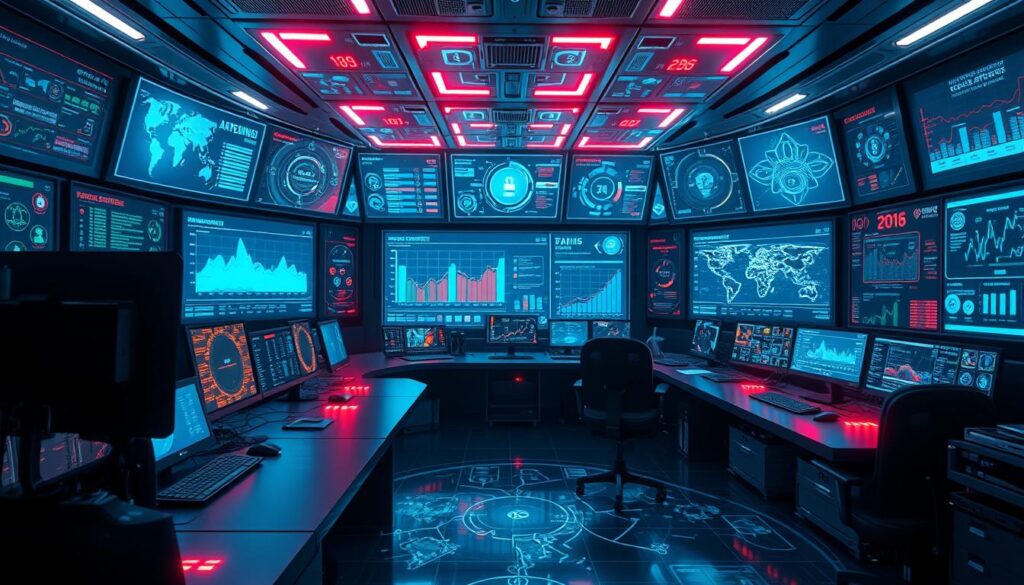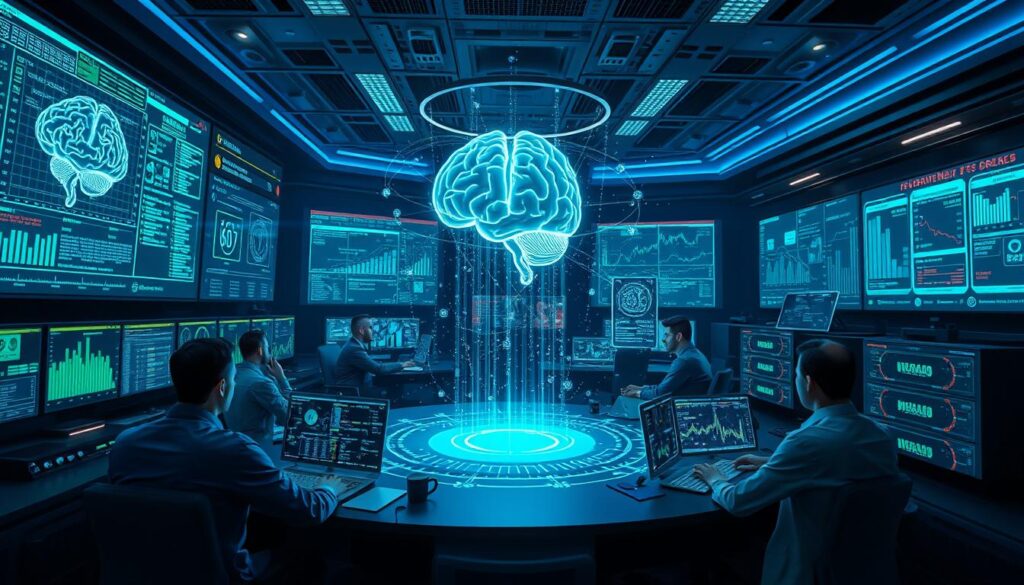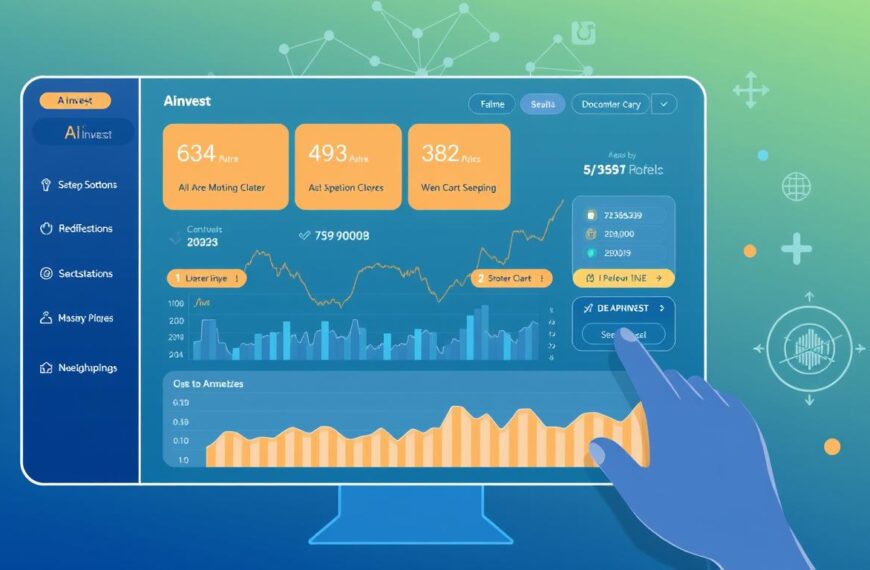The global market for AI-based cybersecurity products is growing fast. It went from $15 billion in 2021 to a predicted $135 billion by 2030. This shows how crucial AI-driven security solutions are. Traditional security methods often can’t keep up with new cyber threats.
But, AI is changing how we protect our data and assets. It uses machine learning to improve threat detection and response. AI analyzes lots of data quickly to spot security breaches, helping us act fast.
This approach not only reduces damage but also keeps our sensitive information safe. AI is now a key part of keeping our digital world secure.
Key Takeaways
- The global market for AI-based cybersecurity products is projected to reach $135 billion by 2030, underscoring the growing importance of AI in protecting digital assets.
- AI enhances cybersecurity by leveraging machine learning algorithms to detect threats in real-time, minimize false positives, and prioritize responses based on actual risks.
- AI-powered solutions can automate security monitoring, reduce manual workload, and provide actionable insights for expedited incident response.
- The integration of AI in cybersecurity has evolved from real-time threat detection to predictive analytics and automated response systems, continuously advancing to combat complex cyber threats.
- AI provides a critical layer of defense against emerging threats, such as deepfakes and data poisoning, while also enhancing traditional security measures like biometric authentication and network traffic analysis.
Understanding the Evolution of Cybersecurity Threats in the Digital Age
The world of cybersecurity has changed a lot, just like digital technology has. What started as simple threats like viruses has grown into complex attacks. The internet and our use of digital systems have made us more vulnerable, leading to a big change in how we protect ourselves.
Current Threat Landscape
At first, cyber threats were just a minor problem, like the Morris Worm in 1988. But as the internet became key for money and personal stuff, hackers started to make money off us. Now, we face threats like phishing and ransomware, which steal our info or lock our files.
Impact of Digital Transformation on Security
Today, cyber threats are more complex and last longer. Advanced Persistent Threats (APTs) are long-term attacks by skilled hackers. We need tools like anomaly detection to spot these threats. With more IoT and AI, hackers will have more targets, making security even more important.
Traditional vs. Modern Security Approaches
To fight these new threats, we need to be proactive and flexible. Machine learning and deep learning help find threats by looking at past data. This shows how machine learning security and deep learning cybersecurity are key for the future. Moving to a Zero Trust Architecture means we must always check who and what is accessing our systems.
“The cybersecurity landscape is constantly evolving, with threats becoming increasingly sophisticated. Digital transformation has introduced new vulnerabilities, necessitating a shift from traditional to modern security approaches.”
AI-driven cybersecurity solutions: A Comprehensive Overview
In today’s world, cyber threats are growing fast. AI-driven cybersecurity solutions are a key tool in fighting these threats. They use advanced machine learning and data analytics to find and stop AI-based threat intelligence and cognitive cybersecurity dangers.
These AI systems can look at huge amounts of data quickly. They spot patterns and oddities that old security systems might miss. This way, they can keep up with new cyber threats, helping organizations defend themselves better.
- AI-driven threat detection uses machine learning to find malware and other suspicious activities by looking at data patterns and user behaviors.
- Automated incident response systems use AI to quickly handle threats, limit damage, and start fixing problems, cutting down attack impact and recovery time.
- AI-powered cloud security solutions watch over cloud infrastructure, find misconfigurations, and protect data in the cloud, keeping digital assets safe.
AI is also changing other parts of cybersecurity, like fraud prevention, identity management, and automating security operations centers. By using AI-based threat intelligence and cognitive cybersecurity, companies can improve their security and stay ahead in a complex digital world.
| AI-driven Cybersecurity Solution | Key Capabilities |
|---|---|
| Threat Detection | Malware analysis, network anomaly detection, behavioral analysis |
| Incident Response | Automated threat evaluation, containment, and mitigation |
| Cloud Security | Cloud infrastructure monitoring, vulnerability detection, data protection |
| Fraud Prevention | Real-time fraud identification, user behavior analysis, anomaly detection |
| Identity Management | Biometric authentication, behavioral analytics, multi-factor authentication |
| SOC Automation | Security event correlation, alert prioritization, automated remediation |
As the digital world keeps changing, AI-driven cybersecurity solutions will become even more important. They will help protect organizations from the growing and complex AI-based threat intelligence and cognitive cybersecurity challenges.
“The future of protecting against cyber-attacks is suggested to rely on continuously updating AI methods to stay ahead of hackers’ latest tricks.”
Machine Learning Algorithms in Threat Detection
In the world of cybersecurity, machine learning algorithms are a game-changer. They analyze huge amounts of data from networks, user actions, and system logs. This helps them spot small changes and patterns that old methods often miss.
Machine learning is great at pattern recognition. It watches network activity and user behavior, learning what’s normal and what’s not. This way, AI-powered security tools can catch threats before they happen, even ones that old methods can’t see.
Anomaly Detection Capabilities
Anomaly detection is another big plus of machine learning in threat detection. These algorithms look at how users and systems act, finding odd behaviors that might mean trouble. They get better at telling good from bad, helping security teams deal with fewer false alarms.
Real-time Analysis Features
Machine learning algorithms work fast, allowing for real-time analysis of security data. This means threats can be caught and acted on quickly. It’s a big step up from old, manual ways of doing things, letting security teams focus on more important tasks.
As the digital world keeps changing, neural network security systems and AI-powered vulnerability management will be more important than ever. They’re changing cybersecurity, making it more proactive and effective against new threats.
Automated Security Analytics and Response Systems
In today’s fast-changing digital world, automated security analytics and response systems are key. They use AI, machine learning, and predictive analytics. This helps them quickly spot and block threats.
Intelligent security automation lets companies protect big and complex networks well. It works faster than people, doing routine tasks. This lets security experts tackle harder problems.
These systems cut down the time to respond to threats. This means less damage and less downtime. They also help find and fix weaknesses before they become big problems.
| Benefit | Impact |
|---|---|
| Accelerated Incident Response | Up to 55% faster alert investigations and triage |
| Reduced Fraud Costs | Up to 90% reduction in fraud costs by balancing security and user experience |
| Threat Landscape Visibility | Identification of vulnerabilities across the threat landscape |
| Data Breach Cost Savings | Average reduction of $3 million in data breach costs |
| Ransomware Attack Mitigation | Faster detection, containment, and response to ransomware attacks |
As cybersecurity keeps changing, automated security analytics and response systems will be more important. They help organizations stay safe from new threats and protect their data and assets.
Enhancing Authentication Through Artificial Intelligence
In today’s world, cybersecurity threats are always changing. Companies are now using AI to make their authentication better. They use advanced biometrics, behavior analysis, and new multi-factor authentication to keep data safe.
Biometric Recognition Advances
AI has changed how we check who’s who. It looks at things like faces, fingerprints, or voices. This makes it hard for hackers to get into important stuff.
Behavioral Analysis Implementation
AI also watches how people act online. It knows what’s normal for each user. If something looks off, it alerts someone right away.
Multi-factor Authentication Innovation
AI brings together biometrics and behavior analysis for extra security. It uses things like face scans, where you are, and what you do. This way, only the right people can get to important data.
As the internet grows, using AI for security will become even more important. It helps companies fight off cyber threats and keep their most valuable things safe.
Predictive Analytics for Cyber Threat Prevention
As cyber threats grow, companies are using AI-based threat intelligence and machine learning security to keep up. Predictive analytics, powered by AI, is key in this fight. It helps predict threats before they happen.
Predictive analytics looks at past data to spot patterns. This lets companies prepare for threats before they hit. It moves security from reacting to threats to preventing them, giving teams a chance to act fast.
At the heart of this is machine learning. It finds oddities, patterns, and predicts future threats. These systems learn from lots of data, getting better at spotting threats over time.
| Key Advancements in Predictive Analytics for Cybersecurity | Impact |
|---|---|
| Pattern Recognition Systems | Identify anomalies and suspicious activities that could indicate potential threats |
| Anomaly Detection Capabilities | Establish baselines for normal behavior and flag deviations for further investigation |
| Real-time Analysis and Threat Monitoring | Enable immediate identification of suspicious activities and provide timely threat intelligence |
With predictive analytics, companies can outsmart cybercriminals. They can stop attacks before they start. This new way of fighting cyber threats is a big win for keeping data and assets safe.
Securing IoT Ecosystems with AI Technology
The Internet of Things (IoT) is growing fast, making it harder to keep these networks safe. But, using deep learning cybersecurity and neural network security systems is showing promise. These tools help tackle the unique security challenges of IoT.
Device Behavior Monitoring
AI security tools use smart algorithms to watch IoT devices closely. They look at data in real-time to spot odd behavior that might mean a security issue. This way, they can catch threats early and stop them before they cause big problems.
Network Traffic Analysis
Neural network security systems are great at handling the huge amounts of data from IoT networks. They find patterns and oddities in network traffic, helping to quickly spot and handle security problems. This deep look into IoT network activity is key to keeping security strong.
Automated Threat Mitigation
AI security tools also help automatically deal with threats. Deep learning cybersecurity finds and isolates bad devices fast. Neural network security systems adjust security rules as threats change. This quick, automatic action helps reduce the harm from cyberattacks and keeps IoT systems running smoothly.
By using these advanced AI security tools, companies can keep their IoT systems safe. They protect against many cyber threats and keep their devices and networks secure.
| Key Statistic | Insight |
|---|---|
| By 2024, organizations are increasingly turning to AI-driven security solutions for protecting IoT devices and networks. | The growing adoption of AI-powered security solutions highlights the industry’s recognition of their importance in securing IoT ecosystems. |
| Deep Learning, a subset of ML, is beneficial for complex pattern recognition tasks in IoT security. | Advanced AI techniques like deep learning enable more sophisticated threat detection and response capabilities within IoT networks. |
| AI-powered anomaly detection techniques can efficiently identify unusual behavior patterns in IoT networks and devices. | AI’s ability to rapidly detect anomalies helps organizations proactively address potential security vulnerabilities in IoT environments. |
Challenges and Limitations of AI in Cybersecurity
AI-powered vulnerability management and artificial intelligence threat detection are big steps forward in cybersecurity. Yet, they come with challenges and limits that need to be tackled. One major issue is the risk of false positives and false negatives. This means AI might wrongly flag threats or miss real ones.
Another problem is the complexity of AI models. It’s hard for security experts to grasp how these systems make decisions. This lack of clarity can make it tough to use and manage these technologies effectively.
- AI systems need a lot of power and special hardware. This can be a hurdle for some companies to jump over.
- Adding AI to existing security systems is also a challenge. It’s crucial to make sure everything works together smoothly.
Cybercriminals are now targeting AI systems with adversarial attacks. This shows how important it is to protect AI systems from being used as a new attack point.
There’s also worry about AI’s effect on data privacy and legal compliance. AI systems collect and analyze a lot of data. This raises concerns about keeping sensitive info safe and preventing misuse.
The skill gap in AI and cybersecurity is another hurdle. There’s a need for experts in both fields. This makes it hard to build teams that can fully use AI for security.
To overcome these hurdles, companies need to create strong governance, invest in training, and keep checking their AI security tools. This way, they can make the most of AI to boost their defenses and stay ahead of threats.
The Future of AI-Powered Security Systems
The digital world is changing fast, and AI is key in keeping it safe. AI-powered security systems are getting better at fighting new threats.
Emerging Technologies
AI is making cybersecurity better with advanced threat detection and response. These systems use machine learning to spot patterns and anomalies quickly. They also help in automated incident response, better malware analysis, and predictive analytics.
Industry Trends
AI is becoming more common in cybersecurity across all industries. Companies are using AI to improve their security, from detecting threats to responding to incidents. Forbes says 76% of businesses put money in AI and machine learning in 2021.
Innovation Roadmap
The future of AI in security includes better behavioral analytics and User and Entity Behavior Analytics (UEBA). AI will also help in detecting phishing attacks. The CAGR for AI in cybersecurity is expected to grow by 27.8% by 2030.
As intelligent security automation and cognitive cybersecurity grow, security will get smarter. AI will help organizations defend against complex cyber threats. This will make security more effective and proactive.
| Emerging Technologies | Industry Trends | Innovation Roadmap |
|---|---|---|
|
|
|
“The integration of AI into cybersecurity defense strategies enhances the ability to predict, prevent, and mitigate cyber threats.”
Conclusion
AI is changing how we protect our data. It makes threat detection better, automates security tasks, and secures IoT devices. This gives us a strong defense against new cyber threats.
As cybercriminals use new tech, AI becomes more important for keeping our digital world safe. It’s key to fighting off cyber attacks.
Companies need to use AI in their cybersecurity to stay safe. But, they must think about data privacy and the ethics of AI. They also need experts to handle these systems.
By tackling these issues, businesses can use AI to its fullest. This will make their security stronger.
AI-powered security systems are a bright spot in the fight against cyber threats. They use advanced analytics and automation to protect our data and systems. As the AI in cybersecurity market grows, companies that use these solutions will be ready for the future.







